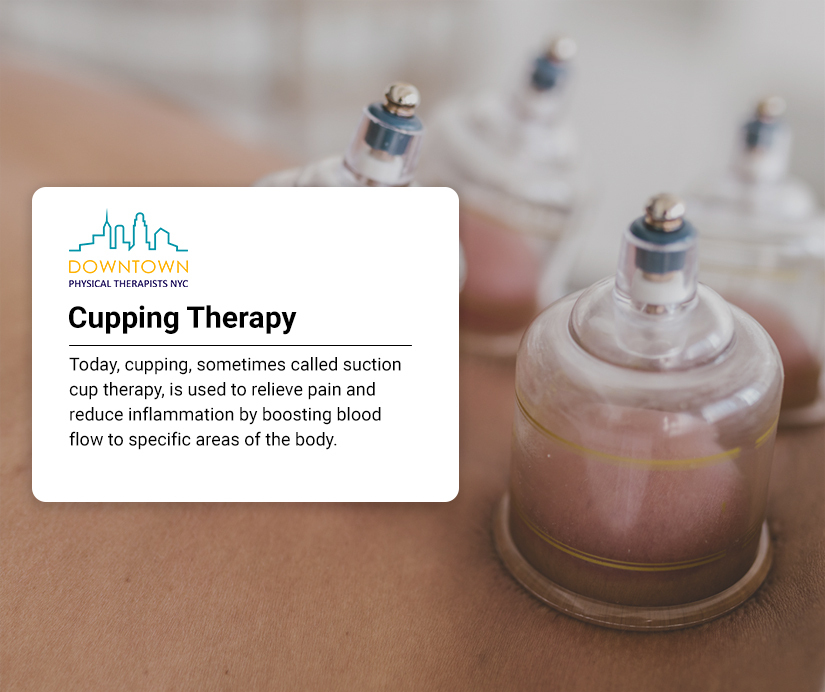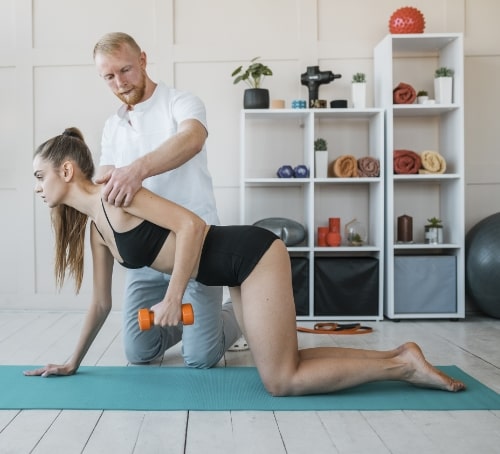Cupping therapy is a treatment for pain relief that has been around for centuries. This ancient Chinese, Egyptian, and Middle Eastern type of alternative medicine is carried out by placing cups on the skin to create suction and reduce chronic and acute pains, soothe trigger points, ease inflammation, and relax spastic muscles. As a form of massage therapy, cupping is also a great way to help loosen phlegm in the lungs, remove disease-causing factors, and promote blood circulation. Come in for an acupuncture treatment and try our cupping therapy, which has earned our physical therapists well-deserved praise from each patient they have treated.
Today, cupping, sometimes called suction cup therapy, is used to relieve pain and reduce inflammation by boosting blood flow to specific areas of the body.
It can be quite relaxing for some and might also be used with cupping massage to get maximum results.
How Does Cupping Treatment Work?
Cupping treatment is done by placing a cup directly onto the skin, either the cup is heated in some manner, or it’s pumped to create suction. The cups are left in place for a few minutes to pull the skin, fascia, and muscles apart. It’s almost the opposite of most physical therapy massage techniques which use compression to push soft tissue together, instead cupping uses suction as a pulling method.
Cupping is non-invasive and only leaves some bruising and skin irritation after use. Both of these side effects heal fairly quickly on their own. Cupping uses suction to decompress the muscles and connective tissues which prompts blood flow to the area. This kickstarts the body’s own healing methods. Interestingly, cupping results are most like deep tissue massage, but in reverse. You may hear it referred to as massage cupping therapy.

Dr. Kapadia is very knowledgeable and really helped me with my back pain. Would highly recommend him !
RCI’ve been coming here for a few weeks now for PT and everything has been great. The staff is very friendly and makes the experience comfortable.
ASWhat Is Cupping Physical Therapy Used For?
Who can use cupping and benefit from it? Just about anybody can find some benefit to cupping, especially if they have muscle aches and pains, but it does have specific applications in the world of physical therapy. If you’ve been prescribed this type of treatment or you’re using it for a specific medical condition, then it’s best to make sure you’re seeking cupping physical therapy and not simply an enhancement to a massage.
Cupping is known for providing relief for:
- Shingles
- Facial paralysis
- Cough and lung congestion
- Back pain
- Neck pain
- Myofascial pain syndrome
- Individuals with trigger points
- Arthritis
- Knee pain
- Headaches and migraines
It should be noted that it can also be useful for many people recovering from muscle injuries who want to speed healing in that region. If this is the case, cupping will be paired with other types of physical therapy to get the maximum results.
There are some that suggest cupping therapy in NYC for weight loss is an option. This is not scientifically proven, but cupping can decrease inflammation and reduce the appearance of cellulite by breaking it up and releasing toxins from the body. Both of these effects can have the appearance of weight loss and might be beneficial if used with a calorie modification and exercise program for weight loss.
Consultation

Things to Know About Cupping
Cupping as a treatment modality is not new, it’s been around for thousands of years and used in different parts of the world regularly. There is no official certification for cupping, so it’s important that you do your research and find qualified health care professionals that you trust to perform this procedure.
Cupping can be very beneficial and acts like a deep tissue massage, in reverse. It also is reported to be much less painful than therapeutic massage and even relaxing to some. At Physical Therapists NYC, we believe that skilled cupping can be very beneficial for certain conditions, and we’ll often pair it with other treatment modalities, so you get the maximum benefit possible.
There are some groups of individuals who should stay clear of cupping or extra caution should be exercised. These are children under four years old, seniors or anyone who has fragile skin, and pregnant women should not have cupping in the abdomen or lower back. Other things to consider are the condition of your skin, in addition to avoiding cupping if you have thinning of the skin, it’s also not a good idea if you have a burn of any kind, this includes sunburns, a wound, ulcers, and any internal organ disorders.
What Should You Not Do After Cupping?
After cupping therapy, it’s important to take some precautions to help minimize the risk of side effects and ensure you get the most benefit from the treatment. Some preventive measures to consider after cupping include:
- Avoid exposing the treated area to extreme temperatures. After cupping, it’s best to avoid exposing the treated area to extreme temperatures, such as hot showers, saunas, or ice baths. This can help minimize the risk of further irritation or injury to the skin.
- Avoid overexerting yourself. It’s important to avoid any strenuous exercise or activity for at least 24 hours after cupping. This can help prevent further injury or damage to the treated area and give your body time to heal.
- Don’t apply pressure to the cupping marks. While the cupping marks may be sore or tender, it’s important to avoid applying any pressure to them. This can help prevent further irritation or injury to the skin.
- Abstain from alcohol. It’s best to avoid drinking alcohol for at least 24 hours after cupping. This can help prevent further inflammation or irritation in the body.
- Don’t skip meals. After cupping therapy, it’s important to stay well-hydrated and nourished. It’s best to avoid skipping meals or depriving your body of essential nutrients, as this can affect your body’s ability to heal and recover.
If you experience any unusual or concerning symptoms, such as severe pain, swelling, or infection after cupping, inform our doctor right away.
FAQ
What Are the Cupping Marks and What Do They Mean?
Cupping marks are circular bruises or discolorations that can appear on the skin after undergoing a cupping therapy session. The marks are usually painless and can range in color from pink to purple to brown. They typically last for a few days to a week, depending on your skin type and the intensity of the cupping session.
Is Cupping Therapy Effective?
Some potential benefits of cupping therapy that has been reported include:
- Pain relief. Cupping therapy may help to relieve pain, particularly in the neck, shoulders, and back.
- Improved circulation. The suction created by the cups can increase blood flow and promote the body’s natural healing processes.
- Reduced inflammation. Cupping therapy may help reduce inflammation in the body, helping prevent a variety of health issues.
- Relaxation. Many patients find cupping therapy to be a relaxing and stress-relieving experience.
Does Cupping Hurt?
Cupping therapy is generally considered a safe and non-invasive treatment. Most patients do not experience any pain during the procedure.
Book Your Physical Therapy Appointment Now at Physical Therapists NYC
At Physical Therapy NYC, we believe that cupping should be treated with the regard that any medical procedure or physical therapy modality receives. That’s why our staff is very well-trained and experienced. They will do cupping when it is most beneficial for the patient to receive this care and they’ll thoroughly explain the process at the time, so it doesn’t feel strange or foreign.
Our patients are our top priority, and our goal is to bring you long-term pain-free relief with the most effective treatment plan possible. Led by a team of in-house medical doctors, our physical therapy experts can ensure your care is delivered with experience and expertise.
We specialize in treating busy professionals at Physical Therapists NYC, mainly because we are in the heart of the business district. Our downtown location makes it convenient for people who work in the city and on Wall Street to find the time to be seen for care and to have minimal down time in their day. To better accommodate your schedule, we have early morning and evening hours. It should be noted, those are very popular time slots, so we suggest scheduling today to ensure you get the time you want.
In our office, we feature some of the best state-of-the art diagnostic tools available and a well-appointed, full gym for your workouts and exercises. Having the latest and the best technology leads to a faster recovery with less setbacks along the way. We also put a lot of stock in our physical therapy staff, making sure that we have top-rated therapists who are leaders in their field. Your health care is our priority.
Are you currently in NYC with an injury or health condition preventing you from enjoying your life to its fullest? We offer safe and efficient treatment options, including cupping therapy, to help New Yorkers improve their health and well-being. Start taking charge of your life by figuring out if suction cup physical therapy is right for you. Contact us at (212) 386-7979 today to consult your health condition with one of our licensed therapists and take advantage of a carefully devised cupping treatment program.

Dr. Hetarth Kapadia is a licensed physical therapist that has extensive experience working with orthopedic, neurological, and cardiovascular patients, bringing a wealth of knowledge and expertise to the practice.
Dr. Hetarth Kapadia received his Bachelor's degree in physical therapy from S.B.B. College Of Physiotherapy and his Master's degree in Kinesiology from California Baptist University, Riverside, California, with a major in Exercise Science.
Dr. Hetarth is now pursuing his Doctorate in Physical Therapy at Touro College in New York. Before becoming a part of our practice, he worked in New York at various outpatient clinics where he dealt with patients with musculoskeletal and orthopedic disorders.
More about Dr. Kapadia




